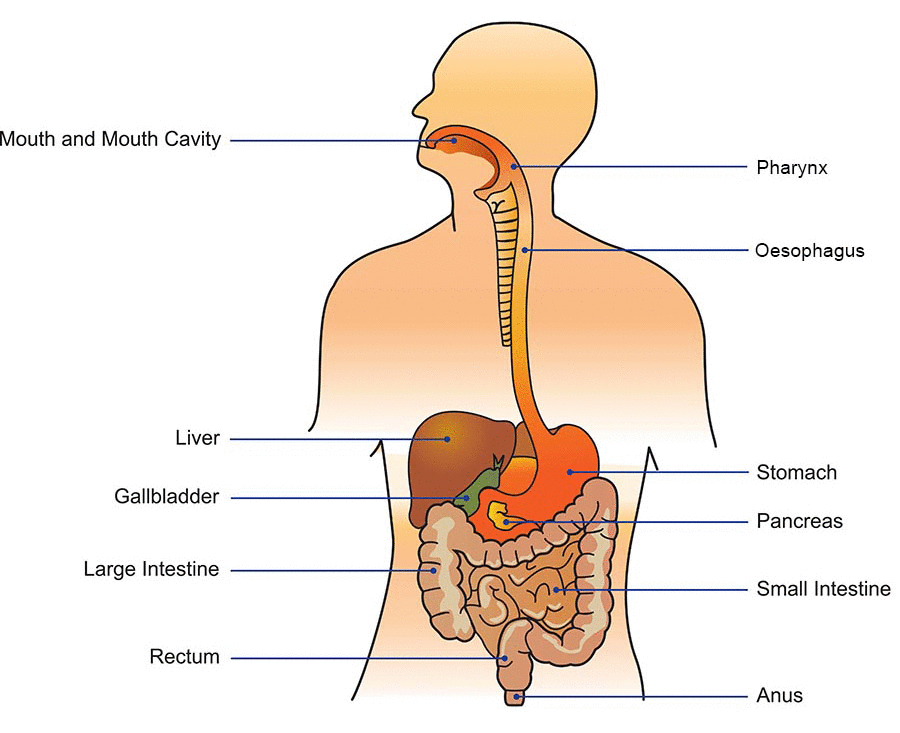The series of structures and organs through which liquids and food pass through for digestion is referred to as the digestive system. It also includes organs that are involved in the waste elimination process.
The human digestive system consists of the gastrointestinal tract and the accessory digestive organs. The human digestive system begins at the mouth and ends at the anus. The liver, gallbladder and pancreas are considered accessory digestive organs. Other components include the mouth, tongue, salivary glands and epiglottis. Let us look at all the components in detail.
Mouth
The mouth is the beginning of the upper gastrointestinal tract. It houses salivary glands, teeth and tongue that begin the process of digestion. There are three pairs of the main salivary glands and about 800-1000 secondary salivary glands present in the mouth. It helps in the lubrication of food by the release of saliva.
Teeth are hard structures made of a material called dentin. Humans have different shapes and sizes of teeth that helps in better mastication of food. The tongue is a sensory muscular organ that gives a sense of taste to the food and helps in the secretion of saliva from the salivary glands.
Pharynx
The pharynx is located behind the nasal cavity at the back of the mouth, just above the oesophagus and larynx. It acts as a passageway for food and air. It connects the mouth to the oesophagus.
Oesophagus
Oesophagus, better known as the food pipe, is a muscular tube through which food passes from the pharynx to the stomach. The ball of food, now known as the bolus, passes through the pipe through rhythmic contractions and muscle relaxations called peristalsis.
Diaphragm
The diaphragm is a membranous structure that separates the thoracic cavity from the abdominal cavity. It allows better flexibility for the passage of food. It also anchors the liver to its bare area. The abdomen passes through the oesophagus by a hole in the diaphragm at T10 level.
Stomach
The stomach is a J-shaped organ that is the largest structure of the digestive system. It is connected to the oesophagus at the upper end and to the duodenum at the lower end. It secretes gastric juice that consists of hydrochloric acid and sodium chloride. A large number of glands secrete mucus to protect the stomach lining from all the chemical secretions.
Spleen
It is the largest lymphoid organ found in the human body. It is also called the graveyard of red blood cells, as all the RBCs and WBCs are digested here. This digestion produces a pigment called bilirubin that is transported to the liver and later secreted in bile.
Liver
The Liver is the second largest organ (skin being the largest) in the human body. It is an accessory digestive gland that detoxifies metabolites, synthesises proteins and secretes biochemicals required for the digestion process.
Pancreas
The pancreas is another accessory digestive gland that functions as both an endocrine and exocrine gland. It secretes insulin and glucagon that helps to maintain the blood glucose levels. Insulin is secreted when the blood sugar level is high; it moves glucose into muscles that can be utilised in the form of energy. Stored sugar is broken down into glucose, which is a glucagon function at the time of low blood sugar levels. The pancreas is situated at the back of the stomach.
Lower Gastrointestinal Tract
The lower gastrointestinal tract includes both small and large intestines. The small intestine includes the duodenum, jejunum and ileum. The large intestine consists of the rectum and anal canal.
Stay tuned with BYJU’S for more updates.



